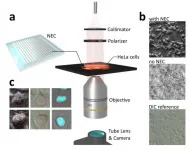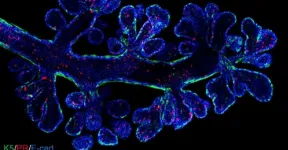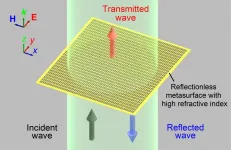Solar wind from the center of the Earth
Model for the Earth's core: Heidelberg researchers verify presence of solar noble gases in metal of an iron meteorite
2021-05-14
(Press-News.org) High-precision noble gas analyses indicate that solar wind particles from our primordial Sun were encased in the Earth's core over 4.5 billion years ago. Researchers from the Institute of Earth Sciences at Heidelberg University have concluded that the particles made their way into the overlying rock mantle over millions of years. The scientists found solar noble gases in an iron meteorite they studied. Because of their chemical composition, such meteorites are often used as natural models for the Earth's metallic core.
The rare class of iron meteorites make up only five percent of all known meteorite finds on Earth. Most are fragments from inside larger asteroids that formed metallic cores in the first one to two million years of our Solar System. The Washington County iron meteorite now being studied at the Klaus Tschira Laboratory for Cosmochemistry at the Institute of Earth Sciences was found nearly 100 years ago. Its name comes from the location in Colorado (USA) where it was discovered. It resembles a metal discus, is six cm thick, and weighs approx. 5.7 kilograms, according to Prof. Dr Mario Trieloff, head of the Geo- and Cosmochemistry research group.
The researchers were finally able to definitively prove the presence of a solar component in the iron meteorite. Using a noble gas mass spectrometer, they determined that the samples from the Washington County meteorite contain noble gases whose isotopic ratios of helium and neon are typical for the solar wind. According to Dr Manfred Vogt, a member of the Trieloff team, "the measurements had to be extraordinarily accurate and precise to differentiate the solar signatures from the dominant cosmogenic noble gases and atmospheric contamination". The team postulates that solar wind particles in the primordial Solar System were trapped by the precursor materials of the Washington County parent asteroid. The noble gases captured along with the particles were dissolved into the liquid metal from which the asteroid's core formed.
The results of their measurements allowed the Heidelberg researchers to draw a conclusion by analogy that the core of the planet Earth might also contain such noble gas components. Yet another scientific observation supports this assumption. Prof. Trieloff's research group has long been measuring solar noble gas isotopes of helium and neon in igneous rock of oceanic islands like Hawaii and Réunion. These magmatites derive from a special form of volcanism sourced by mantle plumes rising from thousands of kilometres deep in the Earth's mantle. Their particularly high solar gas content makes them fundamentally different from the shallow mantle as represented by volcanic activity of submarine mid-ocean mountain ridges. "We always wondered why such different gas signatures could exist at all in a slowly albeit constantly convecting mantle," states the Heidelberg researcher.
Their findings appear to confirm the assumption that the solar noble gases in mantle plumes originate in the planet's core - and hence signify solar wind particles from the centre of the Earth. "Just one to two percent of a metal with a similar composition as the Washington Country meteorite in the Earth's core would be enough to explain the different gas signatures in the mantle," states Dr Vogt. The Earth's core may therefore play a previously underappreciated active role in the geochemical development of the Earth's mantle.
INFORMATION:
The research was funded by the Klaus Tschira Foundation. The results of the intricate, high-resolution noble gas measurements were published in the journal Communications Earth and Environment. A researcher from the Max Planck Institute for Chemistry in Mainz also assisted with the project.
ELSE PRESS RELEASES FROM THIS DATE:
2021-05-14
A new analysis of the effects of SARS-CoV-2, the virus causing the current pandemic, on the human body has provided novel insights into the nature of resilience and how we deal with stressful situations. Using COVID-19 as an example, the findings provide a new framework that may be central to managing this disease, minimise the likelihood of ferocious viral outbreaks in the future and deal with other major stresses.
"COVID-19 has been a huge burden on society at all levels. Whilst the prospects are improving in countries with efficient vaccination schemes ...
2021-05-14
UNIVERSITY PARK, Pa. -- Mother fence lizards that experience stress during pregnancy give birth to male offspring with shortened telomeres, or bits of non-coding DNA that cap the ends of chromosomes, according to a Penn State-led study. Shorter telomeres are associated with decreased lifespan in humans; therefore, the team's findings may have implications for human longevity.
"Human men have shorter telomeres than women, which may partly explain why they have shorter lifespans of about seven years," said Tracy Langkilde, professor and Verne M. Willaman dean of the Eberly College of Science. "Our study shows that stress experienced by mothers during gestation could further shorten the telomeres, and therefore the lifespans, of their sons, thereby exacerbating these sex differences." ...
2021-05-14
Increasingly, businesses rely on algorithms that use data provided by users to make decisions that affect people. For example, Amazon, Google, and Facebook use algorithms to tailor what users see, and Uber and Lyft use them to match passengers with drivers and set prices. Do users, customers, employees, and others have a right to know how companies that use algorithms make their decisions? In a new analysis, researchers explore the moral and ethical foundations to such a right. They conclude that the right to such an explanation is a moral right, then address how companies might do so.
The analysis, by researchers at Carnegie Mellon University, appears in Business Ethics Quarterly, a publication of the Society for Business Ethics.
"In most cases, ...
2021-05-14
Scientists at the National Institutes of Health determined that stomach inflammation is regulated differently in male and female mice after finding that androgens, or male sex hormones, play a critical role in preventing inflammation in the stomach. The finding suggests that physicians could consider treating male patients with stomach inflammation differently than female patients with the same condition. The study was published in Gastroenterology.
Researchers at NIH's National Institute of Environmental Health Sciences (NIEHS) made the discovery after removing adrenal glands from mice of both sexes. Adrenal glands produce glucocorticoids, hormones that have several functions, one of them being suppressing inflammation. With no glucocorticoids, the female mice soon ...
2021-05-14
In 1961, the Nobel prize winning theoretical physicist Eugene Wigner proposed what is now known as the Wigner's friend thought experiment as an extension of the notorious Schroedinger's cat experiment. In the latter, a cat is trapped in a box with poison that will be released if a radioactive atom decays. Governed by quantum mechanical laws, the radioactive atom is in a superposition between decaying and not decaying, which also means that the cat is in a superposition between life and death. What does the cat experience when it is in the superposition? ...
2021-05-14
A study led by LMU plant biologist Hans-Henning Kunz uncovers a new role for ion transporters: they participate in gene regulation in chloroplasts.
In plants, photosynthesis takes place in intracellular 'factories' called chloroplasts. Plant chloroplasts evolved from photosynthetic cyanobacteria, which were engulfed by a non-photosynthetic cell in the course of evolution. As a result of this evolutionary event, chloroplasts possess two envelope membranes, and have retained functional remnants of their original cyanobacterial genomes. Henning Kunz (LMU Biocenter), his group, and their collaborators have now demonstrated that ...
2021-05-14
Input one, output one; input two, output two; input three; output purple --what kind of system is this? Computer algorithms can exist as non-deterministic systems, in which there are multiple possible outcomes for each input. Even if one output is more likely than another, it doesn't necessarily eliminate the possibility of putting in three and getting purple instead of three. Now, a research team from Iowa State University has developed a way to control such systems with more predictability. The results were published in IEEE/CAA Journal of Automatica Sinica.
"The supervisory control problem for discrete event systems under control involves ...
2021-05-14
The ability to visualize transparent objects such as biological cells is of fundamental importance in biology and medical diagnostics. Conventional approaches to achieve this include phase-contrast microscopy and techniques that rely on chemical staining of biological cells. These techniques, however, rely on expensive and bulky optical components or require changing, and in some cases damaging, the cell by introducing chemical contrast agents. Significant recent advances in nanofabrication technology permit structuring materials on the nanoscale with unprecedented ...
2021-05-14
Australian researchers have documented the diversity of cells in the human breast, explaining the relationship between healthy breast cells and breast cancer cells.
The research, which relied on expertise spanning from breast cancer biology through to bioinformatics, measured gene expression in single cells taken from healthy women and cancerous breast tissue, including tissue carrying a faulty BRCA1 gene. This enabled the researchers to create an 'RNA atlas' that details the different cells found in these tissues.
The atlas, which was described in EMBO Journal, ...
2021-05-14
Japanese researchers successfully tested reflectionless, highly refractive index metasurface that may eventually be used in practical applications to send, receive, and manipulate light and radio waves in the terahertz waveband (THz). THz is measured in millionths of a meter, known as micrometers. The metasurface, an artificial two-dimensional flat material, was made of micro-sized cut metal wires of silver paste ink placed on both the front and back of a polyimide film. The team, led by Takehito Suzuki, Associate Professor at the Tokyo University of Agriculture and Technology (TUAT) Institute of Engineering, published their findings on April 29, 2021 in Optics Express.
Such flat metasurfaces ...
LAST 30 PRESS RELEASES:
[Press-News.org] Solar wind from the center of the Earth
Model for the Earth's core: Heidelberg researchers verify presence of solar noble gases in metal of an iron meteorite





